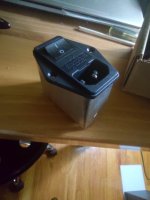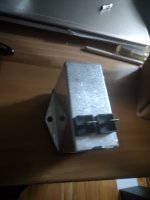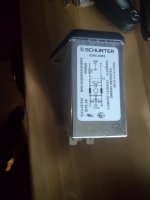as jean-paul sez - when done properly, choice of proper solutions is much broader
spade connectors are good, when they are good ........ but people not doing that professionally rarely make proper choices, both in selecting and actually doing it.
that's why I'm preaching - solder everything...... if nothing else, that leads to uniformity of errors
spade connectors are good, when they are good ........ but people not doing that professionally rarely make proper choices, both in selecting and actually doing it.
that's why I'm preaching - solder everything...... if nothing else, that leads to uniformity of errors
Thanks! I appreciate you will solve this so noobs like me can learn how to avoid these failures. Your expertise is greatly admired and appreciated.No problem, avoiding is what it is about. I have witnessed pretty heavy demolition after incidents and when no one was hurt things can be both exciting and comical (but we don't laugh in public 🙂).
Yes, once I get home later on. For the most part, the drawer suffered the majority of the damage. I will replace the entire unit anyway, need to find one without fuses that fits the hole. I have two rear panel finishing kits from store arriving today, not sure if they even fit, seems like I read the opening is now different.@Russellc,
Can you shows pics of the PEM connection side?
These are the only two of my amps that this happened to. I don't think it had anything to do with it, but these same two amps I did an experiment on, based on another members post called something like "converted to mono blocks for $10" or similar.
One board was removed from each, and placed in the other, so each amp had one board from each amp. A switch was installed that lite up one board at the time, converting it to mono blocks
Ran them like that for a while, determined I didn't prefer it and returned them to individual amps. Fuses have not been changed since then, and that was a while back, over a year at least.
I have been feeling the drawers on amps lately, but none feel hot!
The only thing I can think of is the 4 amp fuses, but still, all of my amps have 4 amp slow blos. 2.5 amp slo blo, should be getting delivered soon.
The questions are:
1. Were these 10 year old amps assembled the very same way so had they soldered or crimped wiring?
2. If soldered: were the fuse holders soldered more than just once because of the monobloc conversion?
3. Did they have the same brand/type fuses?
4. Are the fuse holders 100% identical?
1. Were these 10 year old amps assembled the very same way so had they soldered or crimped wiring?
2. If soldered: were the fuse holders soldered more than just once because of the monobloc conversion?
3. Did they have the same brand/type fuses?
4. Are the fuse holders 100% identical?
Last edited:
The 10 year old and the M2 and Alephj are similarly built. Soldered. As to actual shurter and fuse holders, all were from diystore rear panel kits, whatever they used. No idea on fuse brand, from mouser and or digikey.
When conversion happened, wiring to scherter unmolested, done at other end.
The 10 year old BA3 used store delay (just like 6l6's BA3 build guide.) while the other two amps used the typical Pass unit with the CL 60 devices to slow surge.
While I'm not sure how or why, other than 4 amp slow blo thing, the conversion to monoblocks was only real difference, something could have happened then I suppose.
I ran PoP hard last night with it's temporary power supply, wiring is crimped only on schurter, tabs ARE soldered to the wire. The back of the drawer is cool, and inspected upon shutdown, all fine.
When conversion happened, wiring to scherter unmolested, done at other end.
The 10 year old BA3 used store delay (just like 6l6's BA3 build guide.) while the other two amps used the typical Pass unit with the CL 60 devices to slow surge.
While I'm not sure how or why, other than 4 amp slow blo thing, the conversion to monoblocks was only real difference, something could have happened then I suppose.
I ran PoP hard last night with it's temporary power supply, wiring is crimped only on schurter, tabs ARE soldered to the wire. The back of the drawer is cool, and inspected upon shutdown, all fine.
It is somewhat surprising that we don’t hear about more people hurting themselves with DIY projects that involve mains wiring. Perhaps a cynical answer is that since they die in the fire there is no one left to report on the misadventure.
I would suggest that choosing the correct mains fuse is anything but trivial. Maybe the most surprising aspect of this thread is that it has not been suggested that the current draw of the amp be observed such that a fuse of the correct type and size can be chosen. Not having the equipment to safely perform such testing doesn’t discharge the requirement that the information is needed. Also, keep in mind that the role of the fuse is to open when a component failure that would otherwise draw excessive current occurs. Testing that mimics a component failure to ensure that the correct fuse has been chosen is a really good idea. Or just never go to sleep with the equipment left on…
I would suggest that choosing the correct mains fuse is anything but trivial. Maybe the most surprising aspect of this thread is that it has not been suggested that the current draw of the amp be observed such that a fuse of the correct type and size can be chosen. Not having the equipment to safely perform such testing doesn’t discharge the requirement that the information is needed. Also, keep in mind that the role of the fuse is to open when a component failure that would otherwise draw excessive current occurs. Testing that mimics a component failure to ensure that the correct fuse has been chosen is a really good idea. Or just never go to sleep with the equipment left on…
Maybe it isn't that surprising. Folks here are knowledgeable, these amps are known boards used by many here, same with the power supply boards. Lots and lots of examples having been built
I've been around here for a good while, not as long as some. During that time I don't recall anyone burning their house down yet.
They are called by many as burning amps, they are hot running devices.
I've been around here for a good while, not as long as some. During that time I don't recall anyone burning their house down yet.
They are called by many as burning amps, they are hot running devices.
I posted it specifically in Pass Labs because that is the amplifier this occurred in, wanting opinions from those familiar with this amp. You are of course welcome to ignore it. I can't think of s better place to possibly have posted it.Like "Schurter 6765 type IEC inlets failed. Why?"
? In Parts of course, not in Pass Labs.
Nothing was soldered with fuses in the holders.Soldering spade connectors 6.3 or 4.8 mm and this while the fuses are still in the fuse holders would be a double user error.
The versions meant for soldering wires have much smaller contacts for shorter soldering.
I would not reuse any part of it.Russellc,
We have deduced that the PEM that is installed has Failed. If you bypass the failed PEM with a temporary switch and fuse is everything normal
within the amp itself.
You stated that the amps have worked for years, I have worked for years but I sure have some bad days.
The main obvious damage appears to the drawers. I can post better pics once units are removed.
Russellc
I will order some of these and try them. Most fuse holders are very light weight.Not all fuse holders are created equal.
https://www.digikey.com/en/products/detail/eaton-electronics-division/BK-HTB-52I-R/1024132
https://www.digikey.com/en/products/detail/eaton-electronics-division/BK-HTB-66I-R/1024146
High temperature, flame retardant thermoplastic meets UL 94 V-0
I'm taking a new view on these, quite a bit of heat happened.
Once I have time to remove these, I can take pics showing the main unit damage, find serial number etc.
One is pretty fried inside, can see some in first few pics.
The more I think about it, preliminarily I think this damage occurred during the mono block conversion. Whatever happened did so to BOTH amps, no others. These have had the same fuses in them for years.
I find it hard to believe this thing would have got "melt" hot without failing over last couple years. Possible that damage occurred, amps still functioned and held up all this time? Seems more likely but no less scary
Might be the weekend before I will have time.
Only one fuse survived in one piece, it says BUSS on one end
One is pretty fried inside, can see some in first few pics.
The more I think about it, preliminarily I think this damage occurred during the mono block conversion. Whatever happened did so to BOTH amps, no others. These have had the same fuses in them for years.
I find it hard to believe this thing would have got "melt" hot without failing over last couple years. Possible that damage occurred, amps still functioned and held up all this time? Seems more likely but no less scary
Might be the weekend before I will have time.
Only one fuse survived in one piece, it says BUSS on one end
"Once I have time to remove these, I can take pics showing the main unit damage, find serial number etc...."
The pic of most interest to me would be the backside of the Schurter unit in Post#'s 1 & 2.
No need to remove it, show it in its 'as is' state.
The pic of most interest to me would be the backside of the Schurter unit in Post#'s 1 & 2.
No need to remove it, show it in its 'as is' state.
Yes, please. That's the name of the manufacturer.Like "Schurter ..."
- Home
- Amplifiers
- Pass Labs
- Shurter on/off fuse units


